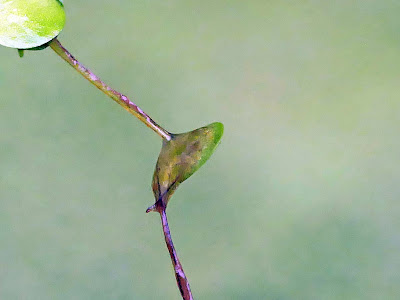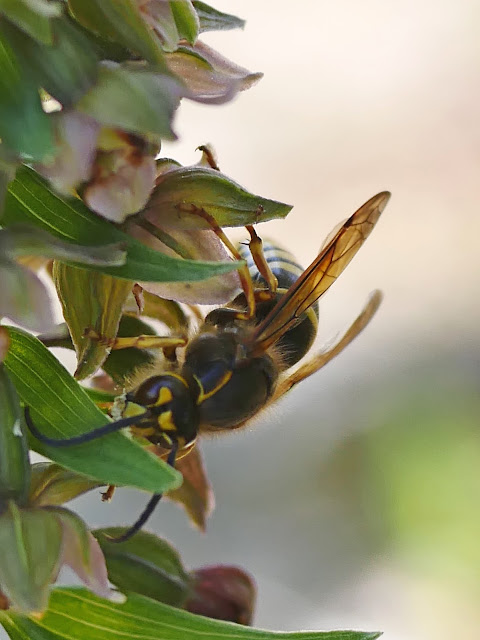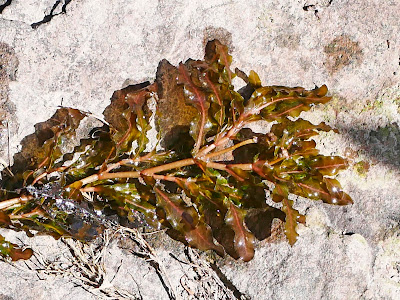The first two weeks or so of July has seen the country suffer a heatwave with temperatures over 30 degrees and commonly in the high 20s for days on end. This gave rise to drought, with even Wood Docks wilting in the woods. The weather has only just given way to cooler temperatures with some drizzle. Hopefully, the surviving plants will get enough water to survive the next heatwave forecast later this month. Here's some of the plants I have seen in the first half of July.
First off was a trip to Tregonetha Downs, West of Bodmin. I chose to record the under-recorded Eastern end which was very overgrown with Western and Common Gorse. At the end of it I had around 100 small punctures and cuts to my lower legs where the spines had gone straight through my jeans. Sometimes the scrub was waist high and was very hard going in the heat. After this, I thought it prudent to get a tetanus jab, as the last one I had was over 40 years ago!
There were still a few Heath Spotted Orchids in flower which was nice.
Dactylorhiza maculata subsp ericetorum
Bell Heather coming into full flower now - Erica cinerea
Cross-leaved Heath dominated much of the heathland.
Erica tetralix
In one of the few damp areas, Marsh Bedstraw was flowering. It looks very similar to Fen Bedstraw, but Marsh lacks mucros (bristle points) on all leaves, and the stems only feel rough in one direction not two.
Galium palustre
Common Yellow Sedge was abundant in places. Its fruits are very similar to mini pineapples and all fruiting clumps are stalked.
Carex demissa
A few Bog Asphodels were hanging on in a few damp areas not swamped with Gorse (yet).
Narthecium ossifragum
Lesser Skullcap from the same damp area.
Scutellaria minor
On the road verge by the heath were some Marsh Woundworts in dappled shade.
Stachys palustris
The final plant of note was on dumped spoil by the roadside. There was easily over a ton of soil, so it was likely either placed there by a farmer or a tipper lorry dumped it here. It was reasonably vegetated, so it had been here a while. Growing by it was some Cornfield Knotgrass, one of the rarer species in this difficult group. The photos show the key characteristics of this plant. It also has an upright habit or may creep along the ground before rising upwards.
Polygonum rurivagum
A few days later I was recording a monad near Week St Mary. After much searching, I found Broad-leaved Helleborines in a dark woodland, last recorded here in 1998.
Epipactis helleborine
I usually find Ivy-leaved Water Crowfoot in the Spring, so it was nice to find some flowering in a series of large puddles caused by cattle on a footpath.
Wild Parsnip does well here. It's the only yellow flowered umbellifer with large pinnate leaves, making ID easy. However, there are three subspecies to consider too. The wild one (below) has strongly angled stems with hairy leaves and stem and no swelling at the base of the stem. A lookalike, the Garden Parsnip (subsp sativa), has a swollen base and is almost glabrous (hairless). The third species is continental (subsp urens) and has recently colonised the M20 in Kent, probably from lorry movements, that one has round stems.
A few days later I took a walk around the Kerdroya labyrinth on the Bodmin Moor. I visited here in the Spring and found many new species to the area, no doubt introduced when the labyrinth was built. It is comprised of many sections of Cornish hedge which are earth filled walls, using stone from all around the county, including Serpentine rock from The Lizard area, so anything could turn up here.
I noticed a tiny white flower on one of the Cornish hedges and found it to be a drought stricken Thyme-leaved Sandwort. If it has needle like leaves consider Slender Sandwort (Arenaria leptoclados) which also has cylinder like pods rather than the flask like ones in Thyme-leaved.
On another wall was a small colony of Alsike Clover. It differs from red and white clover in having unmarked leaves with many branched veins; the stipules taper into a long point; there are no leaflets directly under the flower and the colouring is typical as shown in the photo below.
I rounded off the first half of July with a visit to a part of Cornwall, West of the Tamar, that is in botanical Devon (VC4), to a small village called North Petherwin. A variety of habitats enabled me to record almost 190 species of plants here. The area had only been recorded three times in the 21st Century, so it was good to update and find new records there. One of the best places in the monad for species was the old Otter Sanctuary, now the Willowtree Cafe. Parking is free and after a nice lunch in the friendly cafe, you can walk the woodland and ponds that used to be the otter reserve.
The ponds also had a large population of Curly Waterweed, a species that doesn't look much like anything else, so easily remembered. It's green in early Summer, turning brown as they age. It's quite common in the Bude area too.



















































No comments:
Post a Comment
All comments are moderated before publication, so please don't bother spamming me, thank you. Genuine comments most welcome.